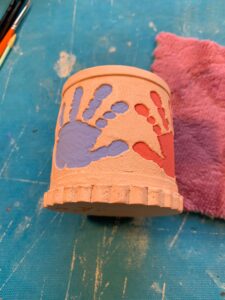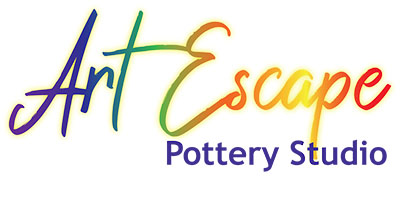
Candle holder being painted
The Intricacies of Glaze and Color Theory
Pottery, with its rich history spanning civilizations and cultures, offers a unique canvas for artistic expression. One aspect that adds depth and dimension to pottery is the use of glazes and color combinations. In pottery classes, students not only learn the fundamentals of shaping clay but also delve into the fascinating world of color theory and glaze application. Guided by knowledgeable pottery teachers, students embark on a journey of experimentation and discovery, exploring the intricacies of color mixing and the transformative power of glazes. Here’s how pottery classes and teachers facilitate the application of color theory in pottery:
Understanding Color Theory: Pottery classes provide a foundation in color theory, teaching students about the principles of hue, value, saturation, and complementary colors. By understanding these fundamental concepts, students gain insight into how different colors interact and how to create harmonious color palettes in their pottery pieces.
Exploring Glaze Chemistry: Glazes, a key component of pottery, consist of complex mixtures of minerals and fluxes that undergo chemical transformations during firing. Pottery teachers guide students through the science of glaze chemistry, helping them understand how different minerals contribute to color development and surface effects in pottery.
Experimenting with Color Combinations: In pottery classes, students have the opportunity to experiment with different color combinations and glaze recipes. From monochromatic schemes to vibrant contrasts, students explore the effects of various color combinations on their pottery pieces, learning through hands-on experimentation and observation.
Learning Glaze Application Techniques: Pottery teachers demonstrate various glaze application techniques, such as dipping, pouring, brushing, and spraying, allowing students to achieve different surface effects and color variations in their pottery. Through practice and guidance, students develop proficiency in applying glazes to achieve their desired aesthetic effects.
Understanding Firing Temperatures: Firing temperatures play a crucial role in color development and glaze effects in pottery. Pottery teachers educate students about the impact of firing temperatures on glaze maturation, color intensity, and surface texture, empowering them to make informed decisions about firing schedules for their pottery pieces.
Exploring Surface Decoration: Surface decoration techniques, such as carving, sgraffito, and underglaze painting, offer additional opportunities for incorporating color and texture into pottery pieces. Pottery classes provide instruction and guidance on these techniques, allowing students to enhance their pottery with intricate patterns, designs, and motifs.
Receiving Feedback and Critique: Pottery teachers offer feedback and critique to students as they experiment with color and glaze application techniques. By providing constructive criticism and guidance, teachers help students refine their color choices and glaze applications, fostering growth and development in their pottery practice.
Cultivating Personal Style: As students gain proficiency in color theory and glaze application, they develop their own personal style and aesthetic preferences in pottery. Pottery classes provide a supportive environment for students to explore their creativity and express themselves through color and glaze choices, leading to the development of unique and distinctive pottery pieces.
In conclusion, pottery classes and teachers play a crucial role in facilitating the application of color theory in pottery. By providing instruction, guidance, and opportunities for experimentation, pottery classes empower students to explore the transformative power of color and glaze in their pottery pieces. Through hands-on practice and collaboration with knowledgeable teachers, students gain a deeper understanding of color theory and develop the skills and confidence to create pottery pieces that are both visually stunning and personally meaningful.
